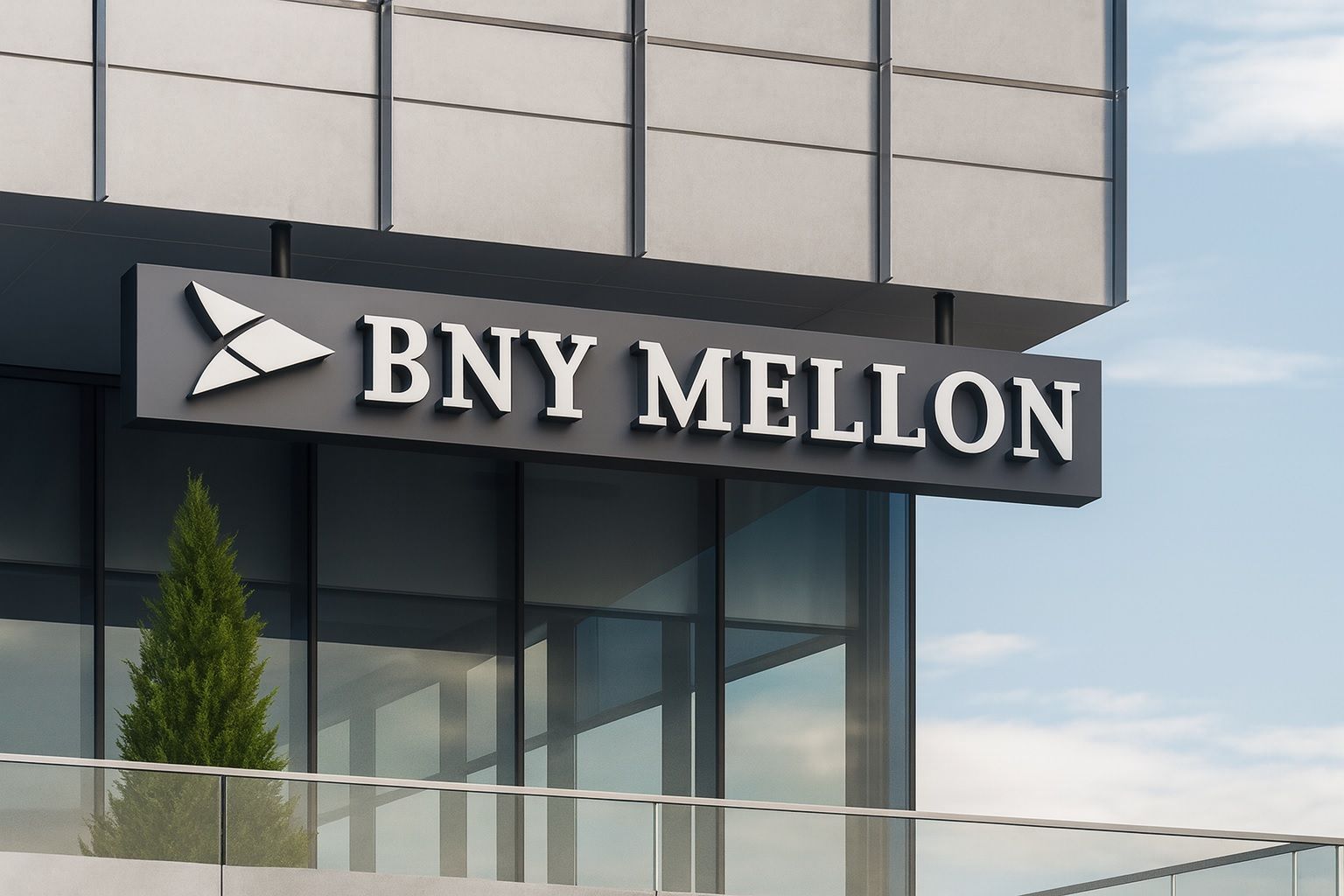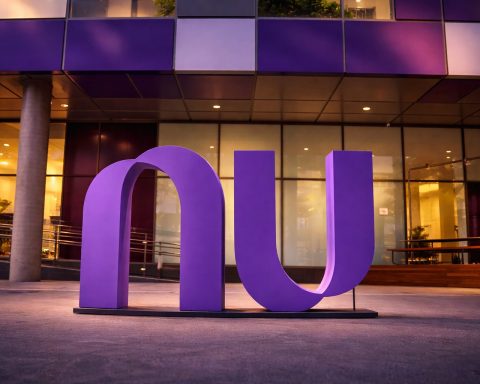- BK stock jumps on earnings beat: BNY Mellon (NYSE: BK) shares are trading around $109 as of Oct. 16, 2025 after closing at $108.93 on Oct. 15 [1]. The stock has gained roughly +2.7% in the past week and +11% over the last quarter [2], extending a powerful 2025 rally of about +40% year-over-year [3].
- Q3 2025 blowout results: The custodian bank delivered record revenue of $5.1 billion in Q3 (up 9% YoY) and earnings of $1.91 per share, topping analyst estimates (consensus ~$1.77) [4]. Net income jumped ~25% from a year ago, as broad-based fee growth and higher interest income drove strong profitability [5] [6].
- Dividend yield tops 2%: BNY Mellon’s board declared a quarterly dividend of $0.53 per share (payable Nov. 7). At the recent share price (~$105–$110), the annualized payout ($2.12) lifts BK’s dividend yield to roughly 2%, a level noted for its contribution to total shareholder returns [7].
- Analysts upbeat but cautious: Wall Street maintains a “Buy” bias on BK with 12-month price targets around $115–$120 [8] [9] – implying modest upside after this year’s surge. Multiple firms launched positive coverage in recent weeks (e.g. BMO Outperform with $125 target) [10]. However, valuation multiples are near multi-year highs [11], and insiders trimmed some shares, underscoring tempered expectations.
- Macro tailwinds and risks: BK’s results underscore resilience amid a banking rally fueled by cooling inflation and Fed rate cuts [12]. Assets under custody swelled to $57.8 trillion (↑11% YoY) on strong markets and client inflows [13] [14]. Still, experts warn that bank stocks’ recent bullishness hinges on continued earnings growth – any economic crack or credit stress could spark a pullback [15].
BK Stock Price & Recent Performance
BNY Mellon’s stock has been on a tear in 2025. Shares are hovering around $109 as of mid-October, after rallying about +40% over the past 12 months [16]. Year-to-date, BK is up roughly +42%, vastly outperforming the S&P 500 and many peer banks. (For perspective, Wells Fargo is +27% YTD [17].) The stock notched a 52-week high of ~$110.87 recently [18] and sits near that peak. Over just the last week and month, BK gained ~2–3%, reflecting a steady uptrend [19].
This strength has come amid a broader financial sector rebound. U.S. bank stocks are “near multi-year highs” as investors position for strong earnings [20]. Optimism about an improving economy and easing interest-rate pressures has lifted sentiment. BNY Mellon’s hefty one-year return signals the market’s confidence in its stability and growth prospects, though it also raises questions about how much future upside remains after such a run. The stock now trades around 16–17× earnings, near the upper end of its 5-year valuation range [21]. Its price-to-book (~2.0×) is likewise approaching decade highs [22]. In short, BK’s rally has rewarded shareholders handsomely, but the bar for further gains is getting higher as the stock price has already climbed significantly.
Q3 2025 Earnings: Record Revenue & Profit Growth
BNY Mellon’s latest quarterly results underscore why the stock has been climbing. Third-quarter 2025 earnings, released on Oct. 16, were better than expected on both the top and bottom lines. The bank reported adjusted EPS of $1.91, beating estimates by about 14 cents [23], and $5.08 billion in revenue, slightly above consensus as well (up ~9% year-over-year) [24] [25]. This marked record quarterly revenue for BNY [26], driven by broad-based strength:
- Fee and other income: $3.85B, up ~7% YoY, as higher market valuations, net new business, and client activity boosted asset servicing and issuer services fees [27]. Notably, BNY’s vast assets under custody/administration (AUC/A) grew to $57.8 trillion (an 11% YoY increase) [28] [29] thanks to client inflows and market gains. This reflects BNY’s role as the world’s largest custodian bank – scale that “underscores its leadership in global asset management” [30]. Assets under management (AUM) were steady at $2.1 trillion [31], as market appreciation offset net outflows.
- Net interest income: $1.24B, up 18% YoY [32], benefitting from higher yields on reinvested securities and growth in balances [33]. BNY capitalized on 2025’s higher-rate environment to earn more on its interest-earning assets, even as deposit costs and mix stabilized. This NII boost has been a common theme across banks this year, though it may moderate if interest rates decline ahead.
- Expenses and leverage: Non-interest expense was up 4% YoY to $3.24B [34], reflecting investments in technology and talent (including the company’s digital transformation efforts and “employee merit increases”) partly offset by efficiency savings [35]. Crucially, revenue growth outpaced costs, yielding positive operating leverage and a strong 36% pre-tax profit margin [36]. Net income applicable to common shareholders came in at $1.339 billion, up 21% from a year ago [37]. On a GAAP basis, diluted EPS was $1.88 (+25% YoY) [38], highlighting significantly higher profitability than the prior year period.
Management noted that performance was “broad-based across our Securities Services and Market & Wealth Services segments” [39]. CEO Robin Vince credited the firm’s “core transformation programs” for improving sales momentum and efficiency, including deployment of new technology. For example, BNY has rolled out an AI-driven platform called “Eliza” to enhance client service and operations [40]. These investments in automation and digital capabilities are helping to expand margins – a fact evidenced by the quarter’s robust 26% YoY growth in adjusted earnings [41].
Shareholder returns were another highlight. In Q3, BNY returned $1.23 billion to shareholders through buybacks and dividends [42]. That included $849 million in common stock repurchases (taking advantage of the strong stock price) and $381 million paid in dividends [43]. The bank’s capital position remains solid even after these payouts: its Common Equity Tier-1 (CET1) ratio stands at 11.7% [44], comfortably above regulatory minimums. This gives BNY ample cushion to continue both investing in growth and returning capital. In fact, the Board maintained the quarterly dividend at $0.53 per share – which had been raised earlier, bringing the annualized dividend to $2.12. With the recent stock gains, BK’s forward dividend yield is about 1.9–2.0% [45]. While not very high, that yield is now meaningfully above the 2% threshold that many income-oriented investors consider attractive [46], especially given the dividend’s steady growth (averaging ~11% increases over 3–5 years [47]).
All told, BNY Mellon’s Q3 showed a healthy mix of growth – rising revenues from both fees and interest – alongside controlled expense growth. The result was a significant earnings beat and arguably one of the bank’s strongest quarters on record. It’s no surprise the stock popped on the news: BK shares rose about +1.7% on Oct. 15 heading into the report [48] [49] and ticked higher in pre-market trading after the results [50]. Investors appeared to focus on the positive earnings surprise and resilient fee momentum, shrugging off a slight revenue consensus miss noted by some outlets (depending on which analyst estimate set is used) [51]. The market’s reaction “cautiously optimistic” tone – BK was up ~0.5% in pre-market and has held those gains [52] – suggests that, while expectations were high, BNY delivered enough good news to reinforce confidence.
Recent News & Developments
Beyond earnings, BNY Mellon has been in the news for several strategic and industry developments that could shape its future performance:
- Blockchain and digital assets initiative: In early October, BNY Mellon made headlines by testing tokenized deposits as part of an effort to modernize its $2.5 trillion daily payments operations. The bank’s treasury services unit processes enormous payment flows, and by tokenizing deposits (i.e. creating blockchain-based representations of bank deposits), BNY aims to enable instant, 24/7 transfers for institutional clients [53]. This pilot, reportedly done in partnership with other major banks like JPMorgan and HSBC, would allow customers to make payments over a private blockchain network, potentially reducing frictions and costs in cross-border transactions [54] [55]. BNY Mellon’s move aligns with a broader industry race to embrace blockchain: as one of America’s oldest banks, it doesn’t want to be left behind in the push for real-time digital payments. A Nasdaq.com report noted the project is structured to facilitate real-time global transfers and cited BNY’s leadership as a positive sign for mainstream adoption of tokenized money [56] [57]. In parallel, BNY is also participating in SWIFT’s new blockchain pilot – a consortium of 30+ banks building a shared ledger for cross-border payments. TS2.tech reported that this on-chain SWIFT project involves “over a dozen banks (including … Bank of New York Mellon)” and is seen as a “defining moment” to supercharge global payments infrastructure [58] [59]. By engaging in these innovations, BNY Mellon is signaling a commitment to fintech evolution, which could yield competitive advantages (or at least keep it at parity with peers) in serving clients with faster, more efficient transaction capabilities.
- Focus on efficiency and tech: Management has frequently highlighted ongoing efficiency drives and tech upgrades. The introduction of the “Eliza” AI platform is one example – it’s designed to leverage artificial intelligence to improve client service and internal operations [60]. BNY’s ability to handle increasing volumes (AUC/A up 11% YoY) without commensurate cost growth reflects these productivity gains. The bank’s transformation program, which CEO Vince has been championing, appears to be yielding fruit in terms of both improved operating margin and new business wins. In the earnings call (and press release), executives emphasized that technology investments are “unlocking further potential for clients and shareholders.” [61] In other words, BNY is using its strong current profits to reinvest in future-proofing its business – a positive sign for long-term investors.
- Dividend and capital moves: As mentioned, BNY Mellon’s dividend is now $0.53/quarter, having been raised earlier to keep the yield competitive as the stock price climbed. The 2% yield milestone is notable – TS2.tech pointed out that historically, reinvested dividends can substantially boost total returns even if price appreciation moderates [62]. BNY’s yield is not high by banking industry standards (some peers have 3–4% yields), but the company has preferred to allocate a greater portion of excess capital to buybacks. In Q3, the share count fell ~4% year-on-year due to repurchases [63], which is accretive to EPS. The bank’s capital return strategy – balancing modest dividend growth with opportunistic buybacks – suggests confidence in its undervaluation earlier this year. Going forward, analysts will watch for any shift in this policy if regulators implement higher capital requirements for large banks (a sector-wide proposal that looms for 2025–2026). For now, BNY’s capital ratios and liquidity (LCR 112%) remain strong [64], meaning it has flexibility to keep rewarding shareholders while meeting regulatory demands.
- Legal and regulatory matters: BNY Mellon has largely avoided major controversies recently, though one news item did emerge in Q4: a lawsuit alleging the bank had inadequate oversight related to dealings with the late Jeffrey Epstein (a case also involving another bank) [65]. BNY Mellon is contesting the claims, and so far it’s not seen as a financially material issue. On the regulatory front, as mentioned, U.S. bank regulators are discussing raising capital buffers for big banks. As a globally significant bank (G-SIB), BNY could face higher capital charges in coming years, which might slightly constrain its returns unless managed carefully. However, with CET1 near 12% and a relatively lower risk loan book (since BNY is more custodial and fee-centric than a traditional lender), it’s better positioned than some consumer banks to handle such changes.
In summary, BNY Mellon is actively adapting to industry trends – from blockchain experiments to AI integration – while maintaining discipline in capital allocation. These developments complement its core earnings story. They show a 239-year-old institution still finding ways to innovate and remain competitive in a changing financial landscape.
Analyst Views and Institutional Activity
Wall Street analysts have generally welcomed BNY Mellon’s recent performance. The stock carries a consensus “Buy” rating across most research coverage [66]. In the wake of Q3 earnings, we’ve seen some bullish commentary: for instance, BMO Capital Markets initiated coverage on Oct. 3 with an Outperform rating and a hefty $125 price target [67], citing BNY’s strong fee franchise and improving efficiency. The average 12-month target among analysts is in the $115 range per share [68] (roughly 7–8% above the latest price), though estimates vary. TipRanks noted a recent analyst reiterating a Buy with a $122 target [69], while StockAnalysis reports the mean target around ~$108–$110 (likely prior to upward revisions) [70] [71]. Taken together, these imply that BK is near fair value but still has some upside if it continues executing well.
Notably, analysts are impressed by BNY’s operating leverage and capital returns. GuruFocus’s post-earnings analysis highlighted that the bank’s net margin reached 26% and ROE ~11.8%, and it characterized financial health metrics as robust [72] [73]. One caution raised was valuation: BNY’s P/E (~16.6) and P/S (~4.2) ratios are at the higher end of its historical range [74]. This suggests the stock isn’t a bargain, so future gains will likely require continued earnings growth. Fortunately, growth expectations are favorable – analysts project ~15% annual EPS growth over the next 5 years [75], reflecting confidence that BNY can expand profitably through a mix of revenue initiatives and share buybacks.
From the investor ownership perspective, BNY Mellon’s shareholder base is dominated by big institutions. Approximately 85–87% of BK’s shares are held by institutional investors and funds [76]. Top holders include large index managers like Vanguard and BlackRock, given BNY’s inclusion in the S&P 500 and its $76+ billion market cap [77]. Such high institutional ownership often brings stability (less volatility) and indicates that “smart money” has confidence in the company’s prospects [78]. Recent 13F filings show that some institutions modestly increased their positions in BNY’s stock over the past quarter, though overall institutional ownership ticked down a bit (net outflows of ~3% reported) as a few investors took profits [79]. One insider data point: GuruFocus noted 20,000 shares sold by insiders in the last three months [80], which is relatively minor in context (BNY has ~705 million shares outstanding). Still, it’s something watchers flag as a potential sign of executives capitalizing on the high stock price – not unusual after a strong run.
One particularly insightful comment on the banking sector’s outlook comes from S&P analyst Nathan Stovall, who said “Banks are a window into the U.S. economy” [81]. In other words, how banks like BNY Mellon perform can reveal the health of broader economic activity (loan growth, trading volumes, corporate finance, etc.). So far, that window shows resilience: clients are actively investing and transacting, and credit quality remains solid at BNY (the bank actually released a small $7 million from credit reserves this quarter) [82]. However, Mac Sykes of Gabelli warned that investors will be watching for “any changes in the credit environment” – any hint of trouble in loan books or client liquidity could change the narrative quickly [83]. BNY Mellon, with its lower direct lending exposure, is somewhat insulated from consumer credit swings, but a major market downturn or corporate default cycle would still affect its fees and assets under custody.
Overall, the sentiment on BK is positive but realistic. The stock is widely seen as a high-quality franchise in financial services, and many analysts consider it a core long-term holding (especially for those seeking exposure to capital markets infrastructure rather than traditional lending). At the same time, with the easy gains already made this year, new investors are likely to be more selective on entry points. The strong institutional backing and continued “Buy” ratings suggest confidence that BNY will navigate current headwinds and continue delivering shareholder value.
Broader Market Context & Macroeconomic Impact
BNY Mellon’s fortunes are closely tied to macroeconomic trends and financial market conditions. The third quarter was marked by an interesting mix of signals: economic growth proved resilient (U.S. GDP and employment held up), while inflation cooled enough for the Federal Reserve to begin cutting interest rates – a rare scenario of easing policy during a still-growing economy. In late September, the Fed enacted a surprise 25 bps rate cut, its first cut after an aggressive hiking cycle [84]. This pivot has had a multi-faceted impact on banks:
- Market rally and asset uplift: Expectations of looser monetary policy ignited a rally in both equity and bond markets. As TS2.tech reported, the Fed’s rate cut and hopes of more to come “fueled a market rally” with major indices popping to new highs [85]. For BNY Mellon, rising asset values directly increase fee revenues (because the assets it custodies and manages are worth more). Indeed, part of the 11% jump in AUC/A was due to higher market valuations on client portfolios [86]. Additionally, improved investor sentiment tends to drive more transaction volumes, new fund launches, and inflows – all beneficial for BNY’s servicing business. The broad-based rally in Q3 (S&P 500 up mid-teens% YTD) created a tailwind for custodian banks like BNY. Fee income rose 7% largely thanks to that “rebounding equities” effect [87] [88].
- Interest rate changes: Up until Q3, higher interest rates had been a boon for BNY Mellon’s net interest income (NII grew +18% YoY as noted) [89]. The bank was able to invest deposits and its own capital at higher yields through much of 2025. However, with the Fed now cutting rates (and potentially more cuts on deck), that tailwind could fade. Lower rates would compress the spread between what BNY earns on assets vs. pays on deposits – likely slowing NII growth ahead or even shrinking it in 2026. On the flip side, lower rates also tend to stimulate economic activity and reduce stress on borrowers. For BNY’s clients, easier financial conditions could mean higher trading volumes, more asset issuance, and greater demand for investment services. There is also a timing aspect: BNY’s interest rate sensitivity is moderate, so a gradual decline in rates might not hurt too badly if offset by volume growth. In the near term, management actually benefited from a quirky curve: the Fed’s cuts steepened the yield curve slightly, which can help certain interest earnings. But if cuts accelerate, banks will adjust by lowering deposit costs. BNY has a large non-interest-bearing deposit base (from its custody clients), which gives it an edge – it doesn’t have to cut a savings rate like consumer banks do. Thus, macro-wise, falling rates are a two-edged sword for BNY Mellon: they trim a source of profit, but they boost the value of stocks and bonds under custody and potentially spark more investor activity.
- Economic outlook and credit: Thus far, there have been few signs of credit deterioration in BNY’s world. Its provision for credit losses in Q3 was actually a benefit (release) of $7 million [90], indicating that previous reserves were more than sufficient. However, observers remain vigilant. If the economy were to tip into recession (for example, if the Fed’s earlier hikes slow things too much or global events cause a downturn), banks could feel it via lower fee revenue and possibly credit losses. BNY is somewhat defensive in this regard – its business model relies more on transaction volumes than loan growth. But a major downturn would likely shrink assets under custody (as market prices fall) and could cause clients to pull back on investing. So far, that hasn’t happened; in fact, Jerome Powell recently noted the economy is still growing, with only a “sharp hiring slowdown” as a concern, and signaled the Fed may even pause balance sheet tightening to avoid undue stress [91] [92]. The prevailing view is that the U.S. may achieve a soft landing, which would be a Goldilocks scenario for banks – lower rates but no recession. BK’s current performance reflects something close to that ideal: robust fee growth (suggesting healthy client activity) alongside still-elevated interest earnings.
In the broader industry landscape, BNY Mellon also faces competitive and regulatory currents. On competition: other custody banks like State Street and Northern Trust are vying for institutional clients and assets. BNY’s record AUC suggests it’s holding its own, possibly even gaining share. Interestingly, in Q2 there were reports that BNY approached Northern Trust about a merger [93]. Northern Trust rebuffed the idea, and analysts doubted a deal would happen due to regulatory hurdles [94]. But the rumor underscores that consolidation is on bankers’ minds – scale is crucial in the low-margin trust and custody business. Even without a merger, BNY may pursue bolt-on acquisitions or partnerships (especially in fintech or asset management) to keep growing.
Regulatory-wise, banks are awaiting new capital rules (Basel 4 implementation in the US) which could force higher capital ratios. BNY’s management has downplayed the impact, noting they “have so much… organic potential” to grow and can adapt over the medium term [95]. They also highlighted that being conservative now (with CET1 ~11.7%) puts them in a good position to meet any new requirements without a scramble. Still, this is an overhang to monitor in 2026: higher capital could slightly lower ROE industry-wide, including for BNY.
Finally, global macro factors like foreign exchange rates and geopolitical stability matter. A weaker U.S. dollar during Q3 actually helped BNY’s results (boosting the reported value of overseas client assets and fee revenue) [96]. If the dollar fluctuates, it can swing results quarter to quarter. Geopolitical tensions or crises (e.g. in Europe or Asia) can also affect investor confidence and asset flows. BNY Mellon, with operations in 35 countries and a presence in all major markets [97], is globally diversified. That’s a strength, but also means it is exposed to macro swings beyond the U.S. Right now, the global picture is mixed – Europe’s growth is slow, China’s recovery is uneven – but the U.S. engine is pulling through. As long as a major shock doesn’t occur, BNY should manage fine. The consensus is that 2025 will end with solid economic growth and perhaps a gentle easing cycle, setting up 2026 for potentially re-accelerating growth (which would be bullish for financial activity levels).
In summary, macroeconomic trends have been net-positive for BNY Mellon in recent quarters, fueling asset growth and fee income. The key risks – an economic hard landing or market correction – are real but not base case scenarios at the moment. As one observer put it, much of the market’s optimism “is built on expected earnings growth – a stumble could trigger a pullback.” [98] BNY’s own outlook will depend on continuing to meet those growth expectations against the macro backdrop. For now, the window into the economy that BNY provides looks clear: moderate growth, declining inflation, and abundant liquidity – conditions under which the bank can thrive.
Outlook: Forecasts and Investment Implications
Looking ahead, what can investors expect for BNY Mellon’s stock? The consensus on Wall Street is that BK has more room to run, albeit at a slower pace than the past year’s breakneck climb. Here are the key factors shaping the outlook:
- Analyst price targets: As noted, the average 12-month target is around $115–$118 [99] [100], roughly in line with the current price plus dividends. This suggests analysts see BK as fairly valued after its rally. However, there are more bullish outliers – some targets in the $122–$125 range [101] [102] imply upside of ~12–15%. These higher targets likely assume BNY can continue delivering earnings beats and perhaps even expand its valuation multiple if the macro environment stays benign. On the other hand, the lowest targets (around $100) see a bit of downside, presumably worried about revenue slowing if interest rates drop off. The spread between high and low targets (roughly $100 to $125) shows there is some disagreement on how 2026 will unfold for BNY. But importantly, none of the major analysts have a “Sell” on the stock – it’s mostly Buys and a few Neutrals [103]. Zacks, for example, ranks BK as a Hold after the earnings pop, noting that the quarterly beat was solid but largely priced in [104]. In contrast, Morningstar analysts might focus on BNY’s wide moat and view any dips as buying opportunities, given its entrenched position in a stable industry.
- Earnings forecasts: For full-year 2025, BNY is on track for around $7.30–$7.40 in EPS (analyst consensus) [105], which would be ~23% growth over 2024 – a very strong year. Going into 2026, current estimates anticipate mid-single-digit growth (EPS ~$7.90 next year) [106]. This deceleration accounts for the likely plateauing of NII and a normalization of equity market returns. If the Fed cuts rates further in early 2026, BNY’s interest income could actually decline, meaning the fee side and any expense cuts would need to pick up the slack to grow earnings. The good news: banks often see a pickup in other areas when rates fall (e.g. refinancing activity, more fund flows). Also, BNY has been reducing share count, which mechanically boosts EPS. Wall Street’s base case assumes BNY can deliver high single-digit EPS growth in 2026. If achieved, that would support the current stock price and likely allow modest appreciation, especially with the near-2% dividend yield as a kicker.
- Strategic opportunities: Longer-term, BNY Mellon’s strategy could unlock new earnings streams. For instance, if its blockchain and digital asset initiatives lead to new services (like custody of tokenized securities or 24/7 payments for institutional clients), that might open incremental revenue lines. It’s still early, but BNY’s embrace of fintech (while measured) could position it as a leader among traditional banks in areas like digital custody. Similarly, any further industry consolidation could be an upside wildcard – if BNY ever did merge with a rival (e.g. State Street or Northern Trust, however unlikely currently), the synergies could be significant. Absent M&A, BNY might grow via partnerships or expanding its asset management offerings (perhaps leveraging its Pershing unit for wealth management). Analysts haven’t explicitly priced such moves in, so they represent potential optionality for the stock.
- Risks to outlook: On the risk side, a key factor is the market environment. BNY’s 40% stock gain over the past year was aided by very favorable markets (with the Nasdaq and S&P posting strong returns). If 2026 were to see a market correction – not impossible given high valuations and global uncertainties – BNY’s fee revenue could stall or drop. Jamie Dimon, CEO of JPMorgan, even cautioned that a 20–30% market correction is conceivable if investor exuberance falters [107]. Such a scenario would likely hit BK’s stock price as well. Another risk is regulation: new capital rules could incrementally reduce ROE, or heightened oversight of custody banks could increase compliance costs. BNY also has to manage cybersecurity and operational risk given the trillions it safeguards; any major incident in that realm, while purely hypothetical, could have outsized repercussions.
That said, BNY Mellon’s overall risk profile is considered lower than a typical bank. It doesn’t make risky loans or engage in volatile trading to the extent Wall Street banks do. Its revenue is more fee-based and recurring. This stability is part of the reason institutional investors favor the stock – as Yahoo Finance noted, BK “is a favorite amongst institutional investors who own ~87%” of the float [108]. Large stakeholders presumably appreciate BNY’s durable business model and have stuck with it through cycles.
For investors considering BK stock now, the calculus may be: is the current ~16× P/E justified and sustainable? If one believes BNY will continue mid-single-digit (or better) earnings growth, then a forward P/E of ~14× (on 2026 EPS) is reasonable. The dividend will likely keep rising ~10% annually, providing growing income. Thus, BK could be a steady compounder rather than a high-flyer from here. Total return projections might be on the order of 8–10% per year (e.g. 5-6% stock appreciation + ~2% dividend), assuming no big surprises. That’s a solid if not spectacular outlook, fitting for a financial stalwart in a mature phase of the cycle.
In conclusion, The Bank of New York Mellon Corporation has delivered on its promises recently – strong earnings, shareholder-friendly actions, and forward-thinking initiatives. The stock’s rally in 2025 reflects that success. Going forward, the company faces the dual challenge of maintaining momentum in a possibly softer interest rate climate while capitalizing on new growth avenues like digital assets. Experts generally remain optimistic: “rising loan demand and spending would signal strength” in the economy, notes BCA’s Irene Tunkel [109], which would benefit all banks, BNY included. As long as the economic expansion stays on track and financial markets avoid major upheaval, BNY Mellon appears poised to continue its steady climb. The days of 40% yearly gains may be behind us, but with its formidable franchise and strategic investments, BK still offers a compelling mix of stability and modest growth. For investors seeking exposure to the financial sector’s infrastructural backbone (custody, clearing, asset management) rather than high-risk lending, BNY Mellon remains a core holding to watch – and one that is adapting to the future even as it anchors itself in centuries-old trust.
Sources: BNY Mellon Q3 2025 Earnings Release [110] [111]; Investing.com [112] [113]; TS2.tech (TechStock²) [114] [115]; Reuters [116] [117]; GuruFocus [118] [119]; TipRanks [120] [121]; FinViz [122] [123]; Nasdaq News [124].
References
1. www.investing.com, 2. finviz.com, 3. www.investing.com, 4. www.investing.com, 5. www.tipranks.com, 6. www.tipranks.com, 7. ts2.tech, 8. www.gurufocus.com, 9. www.tipranks.com, 10. finviz.com, 11. www.gurufocus.com, 12. ts2.tech, 13. www.bny.com, 14. www.bny.com, 15. ts2.tech, 16. www.investing.com, 17. ts2.tech, 18. finviz.com, 19. finviz.com, 20. ts2.tech, 21. www.gurufocus.com, 22. www.gurufocus.com, 23. www.investing.com, 24. www.gurufocus.com, 25. www.gurufocus.com, 26. www.bny.com, 27. www.bny.com, 28. www.bny.com, 29. www.bny.com, 30. www.gurufocus.com, 31. www.stocktitan.net, 32. www.bny.com, 33. www.bny.com, 34. www.bny.com, 35. www.bny.com, 36. www.tipranks.com, 37. www.bny.com, 38. www.tipranks.com, 39. www.bny.com, 40. www.tipranks.com, 41. www.bny.com, 42. www.bny.com, 43. www.bny.com, 44. www.bny.com, 45. ts2.tech, 46. ts2.tech, 47. finviz.com, 48. finviz.com, 49. finviz.com, 50. www.chartmill.com, 51. www.chartmill.com, 52. www.chartmill.com, 53. www.nasdaq.com, 54. www.nasdaq.com, 55. www.nasdaq.com, 56. www.nasdaq.com, 57. www.nasdaq.com, 58. ts2.tech, 59. ts2.tech, 60. www.tipranks.com, 61. www.tipranks.com, 62. ts2.tech, 63. www.bny.com, 64. www.bny.com, 65. www.reuters.com, 66. ts2.tech, 67. finviz.com, 68. www.gurufocus.com, 69. www.tipranks.com, 70. public.com, 71. www.tradingview.com, 72. www.gurufocus.com, 73. www.gurufocus.com, 74. www.gurufocus.com, 75. finviz.com, 76. finviz.com, 77. www.tipranks.com, 78. finance.yahoo.com, 79. finviz.com, 80. www.gurufocus.com, 81. ts2.tech, 82. www.bny.com, 83. ts2.tech, 84. ts2.tech, 85. ts2.tech, 86. www.bny.com, 87. www.reuters.com, 88. www.reuters.com, 89. www.bny.com, 90. www.bny.com, 91. ts2.tech, 92. ts2.tech, 93. www.reuters.com, 94. www.reuters.com, 95. www.reuters.com, 96. www.bny.com, 97. www.gurufocus.com, 98. ts2.tech, 99. www.tradingview.com, 100. www.gurufocus.com, 101. www.tipranks.com, 102. finviz.com, 103. finviz.com, 104. finviz.com, 105. www.chartmill.com, 106. finviz.com, 107. ts2.tech, 108. finance.yahoo.com, 109. ts2.tech, 110. www.bny.com, 111. www.bny.com, 112. www.investing.com, 113. www.investing.com, 114. ts2.tech, 115. ts2.tech, 116. www.reuters.com, 117. www.reuters.com, 118. www.gurufocus.com, 119. www.gurufocus.com, 120. www.tipranks.com, 121. www.tipranks.com, 122. finviz.com, 123. finviz.com, 124. www.nasdaq.com







